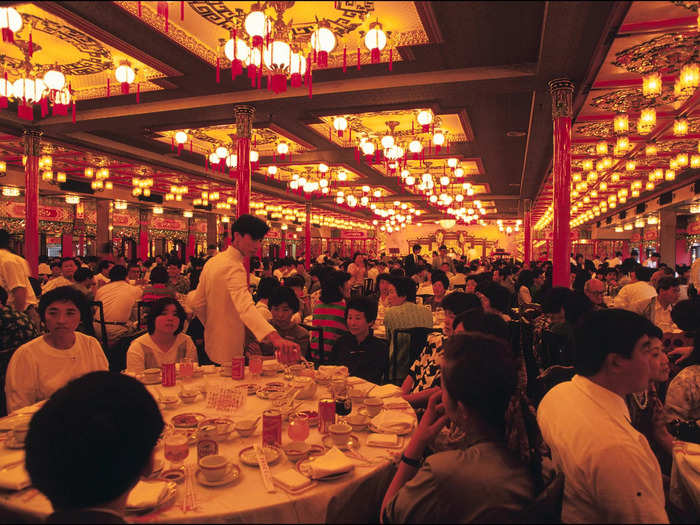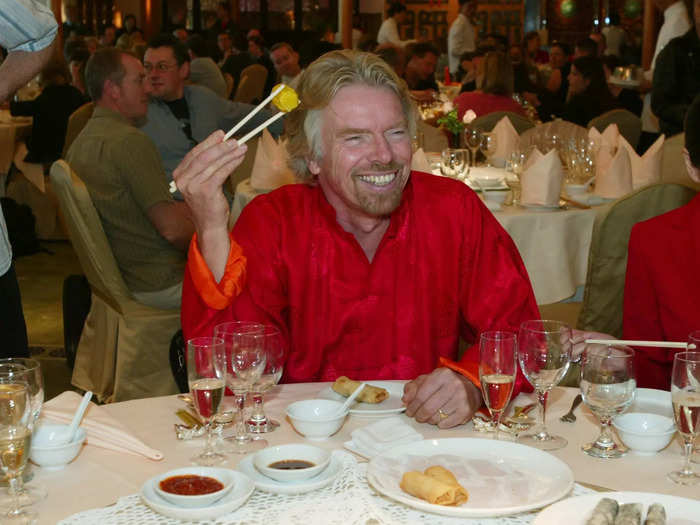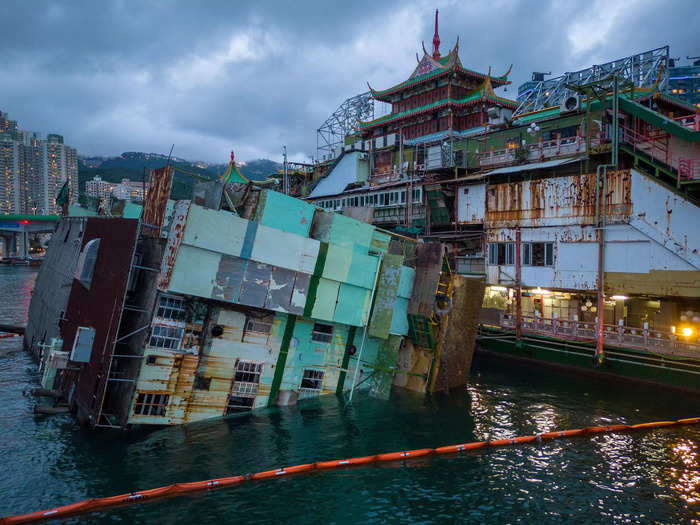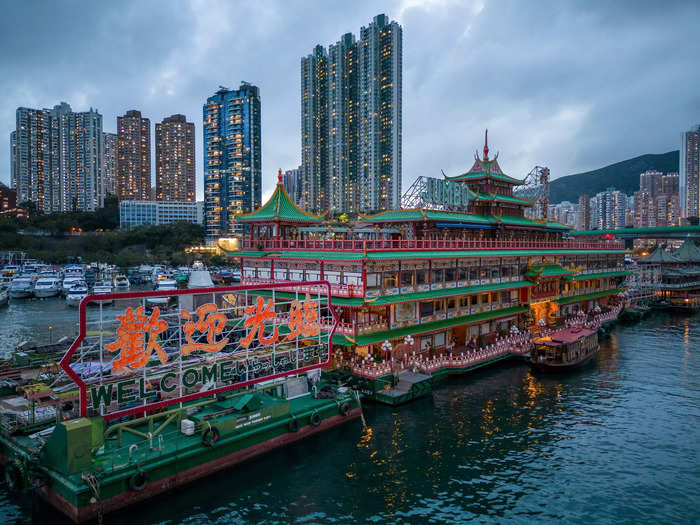The iconic, floating Hong Kong restaurant that could seat more than 2,000 people has capsized at sea. Take a look at the rise and fall of Jumbo Restaurant.
Waiyee Yip
- Jumbo Floating Restaurant, one of Hong Kong's most famous tourist spots, has capsized at sea.
- After halting operations in 2020 amid the pandemic, the eatery struggled to keep up financially.
One of Hong Kong's most iconic tourist destinations, Jumbo Floating Restaurant, has capsized.
After wowing tourists with its grand imperial palace-like design for almost 50 years, the world's largest floating restaurant capsized on Sunday in the South China Sea, per the Associated Press.
According to its parent company Aberdeen Restaurant Enterprises, the restaurant had encountered "adverse conditions" on Saturday when passing the Xisha Islands.
"Water soon entered before it began to tip," the company said in a statement, adding that it was "saddened by this accident," per AFP.
This comes just days after it was towed away from the city due to financial difficulties, per AFP.
It was sad news for Hong Kong residents and foreigners alike, many of whom have viewed the restaurant as a must-see spot ever since it was opened by the late Macau casino tycoon Stanley Ho in 1976.
More than just the food it served — mostly seafood and refined Cantonese cuisine — the eatery was also a novelty for the many tourists who simply enjoyed the journey by a ferry shuttle to get there in the first place.
Aberdeen Restaurant Enterprises and Jumbo Floating Restaurant did not immediately respond to Insider's requests for comment.
In its heyday, visitors flocked to the restaurant for glamorous banquet meals.

With more than 45,000 square feet of space over three floors, the 76 meter-long (246 feet) restaurant could seat 2,300 diners, per SCMP. Its banquet halls could host everything from corporate dinners to weddings.
According to the menu on the restaurant's website, guests could order traditional Cantonese dishes such as roasted suckling pig (HK$230) and double-boiled bird's nest with coconut milk (HK$388).
For tourists, however, it was the live seafood section that was a big draw. At the aquarium-like place, located on an attached barge, visitors could personally pick out more than 60 types of fresh seafood for their meals, including crabs, lobster, and a wide variety of fish, per China News.
Built in the style of a Ming Dynasty imperial palace, the restaurant's lavish design was a sight to behold.

According to a 2020 SCMP article, construction work in the seventies cost upwards of HK$30 million ($3.8 million). In comparison, renovations for a 500-square-foot flat in a busy part of town would have cost HK$10,000 at the time, per the outlet.
Besides the traditional Chinese elements such as the dragon and pagoda motifs running throughout, a large HK$6 million mural on the restaurant's second floor proved to be a hit, the outlet reported. The mural was inspired by a Ming Dynasty Chinese painting and painted by an Italian artist, the outlet said, though it did not specify the name of the artist.
Another big attraction in the restaurant was the dragon throne in the main banquet hall, which included dragon designs that took sculptors two years to carve, per Hong Kong online news outlet HK01.
The restaurant was a hit with celebrities from around the world.

Jumbo Floating Restaurant has hosted more than 30 million visitors, including international celebrities like Queen Elizabeth II and movie stars such as Tom Cruise and Chow Yun Fat, according to its website.
The restaurant has also served as a film set for movies including the James Bond movie "The Man With The Golden Gun" and "The World of Suzie Wong," per HK01.
Stephen Chow's classic Cantonese comedy flick "The God of Cookery" was also shot onboard, including a crucial cooking competition scene, per Taiwan news outlet TVBS.
But after halting operations in 2020 amid the pandemic, the restaurant has struggled to reclaim its former glory.

According to SCMP, the restaurant has reported an accumulated loss in excess of HK$100 million ($12.74 million) after Covid outbreaks stopped tourists from coming.
But the restaurant's financial troubles preceded the pandemic: Prior to the pandemic, the local travel and food and beverage industries were already negatively impacted by the city's social unrest, the outlet reported.
And though the restaurant was completely closed for two years, the company said it still had to spend millions of Hong Kong dollars annually to cover inspection and maintenance works, per SCMP.
Such costs have become "a heavy financial burden for the company and its shareholders in the current economic environment," the company said, per the outlet. "We do not foresee that [Jumbo] can resume business in the immediate future."
The restaurant's woes were exacerbated earlier this month when its kitchen barge — a separate vessel behind the boat — capsized, per Hong Kong newspaper Am730. Investigations are ongoing to determine the cause behind the 30 meter-long (98.4 feet) vessel tilting by nearly 90 degrees, per the outlet. No one was hurt, the outlet reported.
Amid news of the restaurant's imminent exit, fans are calling for support to save it.

Several Hong Kong lawmakers voiced their hopes for the government to do more to help save the business, SCMP reported.
"If the government sees its value, it should step in to take over this boat," Lo Kin-hei of the opposition Democratic Party said, per the outlet.
Hong Kong's lawmaker for tourism, Perry Yiu, said he hoped the government would give the restaurant operator some time to find a "white knight," SCMP reported in another article.
Meanwhile, fans of the restaurant have paid tribute to the restaurant via their art.
Surrealist artist Tommy Fung, for example, shared an image on Instagram of the restaurant sinking, with half of its vessel body submerged. The photo has been liked more than 14,000 times as of publish time.
Illustrator Felix Ip re-imagined the restaurant as a massive robot in an Instagram post. "Goodbye Jumbo!" he captioned.
READ MORE ARTICLES ON
Popular Right Now
Popular Keywords
Advertisement